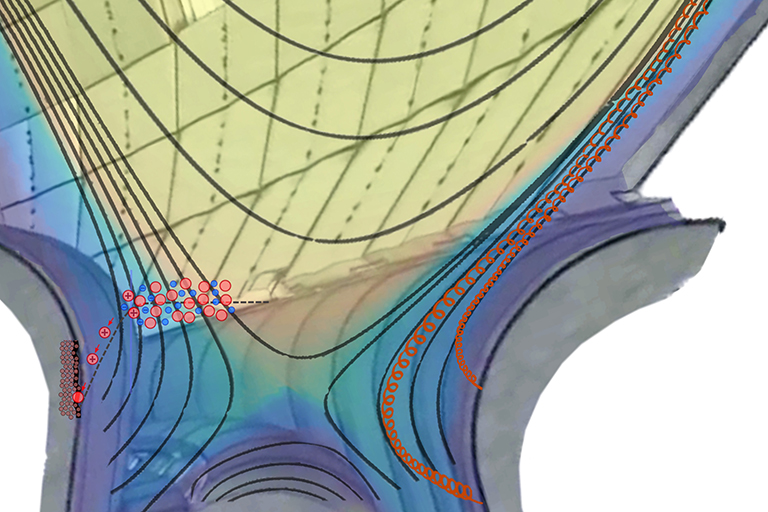
A cross-section view of plasma (hotter yellow to cooler blues and purples) as it interacts with the tungsten surface of fusion. Some of these interactions can degrade the tungsten surface and deplete the fusion reaction over time. Image courtesy of Tim Younkin, University of Tennessee.
That small filament inside a light bulb may look fragile, but it’s made of one of the toughest substances on earth: tungsten.
With the highest melting point of any pure metal, it’s not just useful for light bulbs, but also for future fusion reactors. Despite the as-yet-unsolved scientific and engineering challenges to making fusion a viable energy source, it continues to hold great promise for a sustainable energy future.
However, studying fusion must happen alongside the construction of fusion reactors. ITER, which means “The Way” in Latin and is the world’s largest fusion experiment, is expected to be under construction until 2025. So, for now, fusion experiments relevant to this future device must be conducted via simulation in a laboratory environment with the aid of high-performance computing.
A recent study published in ASCR Discovery by UT-Oak Ridge National Laboratory Governor’s Chair for Computational Nuclear Engineering Brian Wirth and his research team used supercomputing to simulate the behavior of tungsten when it comes into contact with the fusion plasma.
Graduate researcher Timothy Younkin, who contributed to the project, says that tungsten is an ideal candidate for the plasma-facing components because of its high melting temperature and good heat conductivity.
—Timothy Younkin
On an atomic level, tungsten ions are pushing other ions out of the plasma, and radiating energy which is lost from the plasma. This effectively dilutes and cools down the plasma, which then shuts down the fusion reaction and stops producing energy.
The plasma, being such a hot substance, will frequently knock electrons off of the tungsten, but the team wanted to see if the tungsten would follow magnetic field lines back to the surface rather than going into the plasma. Computer modeling allowed them to make predictions about how the tungsten would behave under the extreme heat conditions of the reactor.
The team made use of available computer power and higher fidelity models to create an integrated simulation out of large computer codes instead of attempting to simulate all the physical processes with a single code.
“With inputs from these other codes, the plasma physics codes and the surface codes, we started to build handshakes between these codes so they can pass information and have boundary conditions for each of the respective components,” Younkin said. “We try to take physics that we can compute and validate on the smaller machines and then extrapolate to this next generation machine.”
Although these simulations are contributing important insights, they are just the first steps toward understanding realistic conditions within ITER. These initial models provide a useful foundation, but the researchers must validate the models once ITER is completed.
Contact
Élan Young: elan@tennessee.edu